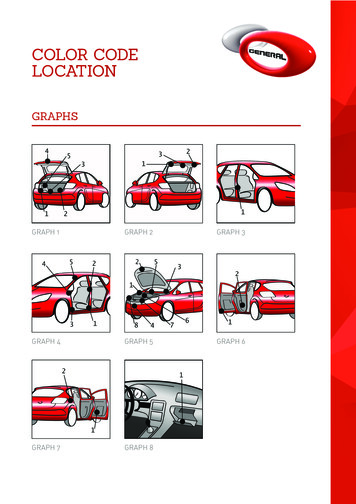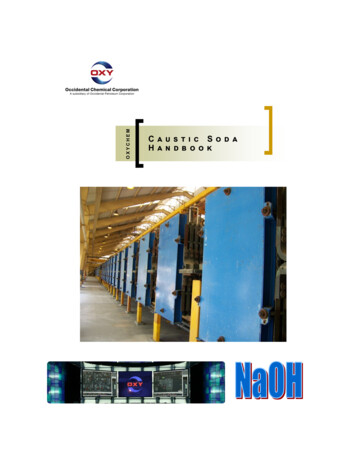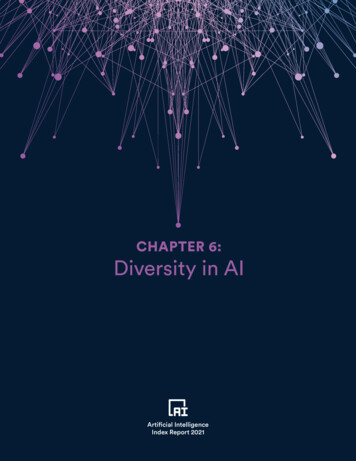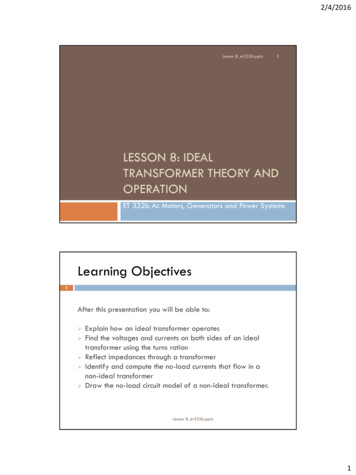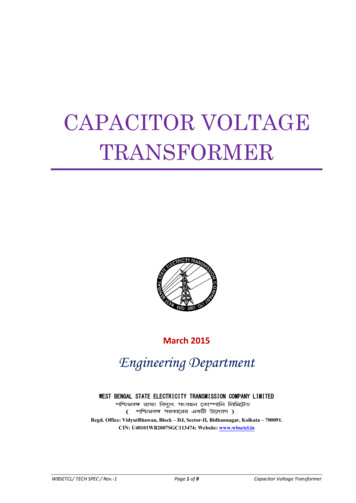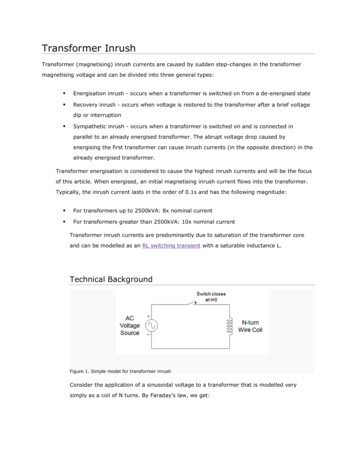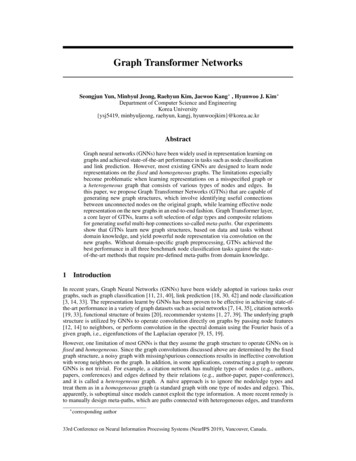
Transcription
Graph Transformer NetworksSeongjun Yun, Minbyul Jeong, Raehyun Kim, Jaewoo Kang , Hyunwoo J. Kim Department of Computer Science and EngineeringKorea University{ysj5419, minbyuljeong, raehyun, kangj, hyunwoojkim}@korea.ac.krAbstractGraph neural networks (GNNs) have been widely used in representation learning ongraphs and achieved state-of-the-art performance in tasks such as node classificationand link prediction. However, most existing GNNs are designed to learn noderepresentations on the fixed and homogeneous graphs. The limitations especiallybecome problematic when learning representations on a misspecified graph ora heterogeneous graph that consists of various types of nodes and edges. Inthis paper, we propose Graph Transformer Networks (GTNs) that are capable ofgenerating new graph structures, which involve identifying useful connectionsbetween unconnected nodes on the original graph, while learning effective noderepresentation on the new graphs in an end-to-end fashion. Graph Transformer layer,a core layer of GTNs, learns a soft selection of edge types and composite relationsfor generating useful multi-hop connections so-called meta-paths. Our experimentsshow that GTNs learn new graph structures, based on data and tasks withoutdomain knowledge, and yield powerful node representation via convolution on thenew graphs. Without domain-specific graph preprocessing, GTNs achieved thebest performance in all three benchmark node classification tasks against the stateof-the-art methods that require pre-defined meta-paths from domain knowledge.1IntroductionIn recent years, Graph Neural Networks (GNNs) have been widely adopted in various tasks overgraphs, such as graph classification [11, 21, 40], link prediction [18, 30, 42] and node classification[3, 14, 33]. The representation learnt by GNNs has been proven to be effective in achieving state-ofthe-art performance in a variety of graph datasets such as social networks [7, 14, 35], citation networks[19, 33], functional structure of brains [20], recommender systems [1, 27, 39]. The underlying graphstructure is utilized by GNNs to operate convolution directly on graphs by passing node features[12, 14] to neighbors, or perform convolution in the spectral domain using the Fourier basis of agiven graph, i.e., eigenfunctions of the Laplacian operator [9, 15, 19].However, one limitation of most GNNs is that they assume the graph structure to operate GNNs on isfixed and homogeneous. Since the graph convolutions discussed above are determined by the fixedgraph structure, a noisy graph with missing/spurious connections results in ineffective convolutionwith wrong neighbors on the graph. In addition, in some applications, constructing a graph to operateGNNs is not trivial. For example, a citation network has multiple types of nodes (e.g., authors,papers, conferences) and edges defined by their relations (e.g., author-paper, paper-conference),and it is called a heterogeneous graph. A naïve approach is to ignore the node/edge types andtreat them as in a homogeneous graph (a standard graph with one type of nodes and edges). This,apparently, is suboptimal since models cannot exploit the type information. A more recent remedy isto manually design meta-paths, which are paths connected with heterogeneous edges, and transform corresponding author33rd Conference on Neural Information Processing Systems (NeurIPS 2019), Vancouver, Canada.
a heterogeneous graph into a homogeneous graph defined by the meta-paths. Then conventionalGNNs can operate on the transformed homogeneous graphs [37, 43]. This is a two-stage approachand requires hand-crafted meta-paths for each problem. The accuracy of downstream analysis can besignificantly affected by the choice of these meta-paths.Here, we develop Graph Transformer Network (GTN) that learns to transform a heterogeneous inputgraph into useful meta-path graphs for each task and learn node representation on the graphs in anend-to-end fashion. GTNs can be viewed as a graph analogue of Spatial Transformer Networks [16]which explicitly learn spatial transformations of input images or features. The main challenge totransform a heterogeneous graph into new graph structure defined by meta-paths is that meta-pathsmay have an arbitrary length and edge types. For example, author classification in citation networksmay benefit from meta-paths which are Author-Paper-Author (APA) or Author-Paper-ConferencePaper-Author (APCPA). Also, the citation networks are directed graphs where relatively less graphneural networks can operate on. In order to address the challenges, we require a model that generatesnew graph structures based on composite relations connected with softly chosen edge types in aheterogeneous graph and learns node representations via convolution on the learnt graph structuresfor a given problem.Our contributions are as follows: (i) We propose a novel framework Graph Transformer Networks, tolearn a new graph structure which involves identifying useful meta-paths and multi-hop connectionsfor learning effective node representation on graphs. (ii) The graph generation is interpretable and themodel is able to provide insight on effective meta-paths for prediction. (iii) We prove the effectivenessof node representation learnt by Graph Transformer Networks resulting in the best performanceagainst state-of-the-art methods that additionally use domain knowledge in all three benchmark nodeclassification on heterogeneous graphs.2Related WorksGraph Neural Networks. In recent years, many classes of GNNs have been developed for a widerange of tasks. They are categorized into two approaches: spectral [5, 9, 15, 19, 22, 38] and nonspectral methods [7, 12, 14, 26, 29, 33]. Based on spectral graph theory, Bruna et al. [5] proposed away to perform convolution in the spectral domain using the Fourier basis of a given graph. Kipf et al.[19] simplified GNNs using the first-order approximation of the spectral graph convolution. On theother hand, non-spectral approaches define convolution operations directly on the graph, utilizingspatially close neighbors. For instance, Veličković et al. [33] applies different weight matrices fornodes with different degrees and Hamilton et al. [14] has proposed learnable aggregator functionswhich summarize neighbors’ information for graph representation learning.Node classification with GNNs. Node classification has been studied for decades. Conventionally,hand-crafted features have been used such as simple graph statistics [2], graph kernel [34], andengineered features from a local neighbor structure [23]. These features are not flexible and sufferfrom poor performance. To overcome the drawback, recently node representation learning methodsvia random walks on graphs have been proposed in DeepWalk [28], LINE [32], and node2vec [13]with tricks from deep learning models (e.g., skip-gram) and have gained some improvement inperformance. However, all of these methods learn node representation solely based on the graphstructure. The representations are not optimized for a specific task. As CNNs have achievedremarkable success in representation learning, GNNs learn a powerful representation for giventasks and data. To improve performance or scalability, generalized convolution based on spectralconvolution [4, 26], attention mechanism on neighbors [25, 33], subsampling [6, 7] and inductiverepresentation for a large graph [14] have been studied. Although these methods show outstandingresults, all these methods have a common limitation which only deals with a homogeneous graph.However, many real-world problems often cannot be represented by a single homogeneous graph.The graphs come as a heterogeneous graph with various types of nodes and edges. Since most GNNsare designed for a single homogeneous graph, one simple solution is a two-stage approach. Usingmeta-paths that are the composite relations of multiple edge types, as a preprocessing, it converts theheterogeneous graph into a homogeneous graph and then learns representation. The metapath2vec[10] learns graph representations by using meta-path based random walk and HAN [37] learns graphrepresentation learning by transforming a heterogeneous graph into a homogeneous graph constructedby meta-paths. However, these approaches manually select meta-paths by domain experts and thusmight not be able to capture all meaningful relations for each problem. Also, performance can be2
significantly affected by the choice of meta-paths. Unlike these approaches, our Graph TransformerNetworks can operate on a heterogeneous graph and transform the graph for tasks while learningnode representation on the transformed graphs in an end-to-end fashion.3MethodThe goal of our framework, Graph Transformer Networks, is to generate new graph structures andlearn node representations on the learned graphs simultaneously. Unlike most CNNs on graphs thatassume the graph is given, GTNs seek for new graph structures using multiple candidate adjacencymatrices to perform more effective graph convolutions and learn more powerful node representations.Learning new graph structures involves identifying useful meta-paths, which are paths connectedwith heterogeneous edges, and multi-hop connections. Before introducing our framework, we brieflysummarize the basic concepts of meta-paths and graph convolution in GCNs.3.1PreliminariesOne input to our framework is multiple graph structures with different types of nodes and edges. LetT v and T e be the set of node types and edge types respectively. The input graphs can be viewedas a heterogeneous graph [31] G (V, E), where V is a set of nodes, E is a set of observed edgeswith a node type mapping function fv : V T v and an edge type mapping function fe : E T e .Each node vi V has one node type, i.e., fv (vi ) T v . Similarly, for eij E, fe (eij ) T e . When T e 1 and T v 1, it becomes a standard graph. In this paper, we consider the case of T e 1.Let N denotes the number of nodes, i.e., V . The heterogeneous graph can be represented by a setN Neof adjacency matrices {Ak }Kis an adjacency matrix wherek 1 where K T , and Ak RAk [i, j] is non-zero when there is a k-th type edge from j to i. More compactly, it can be written as atensor A RN N K . We also have a feature matrix X RN D meaning that the D-dimensionalinput feature given for each node.Meta-Path [37] denoted by p is a path on the heterogeneous graph G that is connected with heterogetlt1t2neous edges, i.e., v1 v2 . vl 1 , where tl T e denotes an l-th edge type of meta-path.It defines a composite relation R t1 t2 . . . tl between node v1 and vl 1 , where R1 R2 denotesthe composition of relation R1 and R2 . Given the composite relation R or the sequence of edge types(t1 , t2 , . . . , tl ), the adjacency matrix AP of the meta-path P is obtained by the multiplications ofadjacency matrices asAP Atl . . . At2 At1 .(1)The notion of meta-path subsumes multi-hop connections and new graph structures in our frameworkare represented by adjacency matrices. For example, the meta-path Author-Paper-Conference (APC),APPCwhich can be represented as A P C, generates an adjacency matrix AAP C by themultipication of AAP and AP C .Graph Convolutional network (GCN). In this work, a graph convolutional network (GCN) [19] isused to learn useful representations for node classification in an end-to-end fashion. Let H (l) be thefeature representations of the lth layer in GCNs, the forward propagation becomes 11H (l 1) σ D̃ 2 ÃD̃ 2 H (l) W (l) ,(2)where à A I RN N is the adjacencyP matrix A of the graph G with added self-connections,D̃ is the degree matrix of Ã, i.e., D̃ii i Ãij , and W (l) Rd d is a trainable weight matrix.One can easily observe that the convolution operation across the graph is determined by the givengraph structure and it is not learnable except for the node-wise linear transform H (l) W (l) . Sothe convolution layer can be interpreted as the composition of a fixed convolution followed by anactivation function σ on the graph after a node-wise linear transformation. Since we learn graph11structures, our framework benefits from the different convolutions, namely, D̃ 2 ÃD̃ 2 , obtainedfrom learned multiple adjacency matrices. The architecture will be introduced later in this section.For a directed graph (i.e., asymmetric adjacency matrix), à in (2) can be normalized by the inverseof in-degree diagonal matrix D 1 as H (l 1) σ(D̃ 1 ÃH (l) W (l) ).3
Figure 1: Graph Transformer Layer softly selects adjacency matrices (edge types) from the set ofadjacency matrices A of a heterogeneous graph G and learns a new meta-path graph represented byA(1) via the matrix multiplication of two selected adjacency matrices Q1 and Q2 . The soft adjacencymatrix selection is a weighted sum of candidate adjacency matrices obtained by 1 1 convolutionwith non-negative weights from softmax(Wφ1 ).3.2Meta-Path GenerationPrevious works [37, 43] require manually defined meta-paths and perform Graph Neural Networkson the meta-path graphs. Instead, our Graph Transformer Networks (GTNs) learn meta-paths forgiven data and tasks and operate graph convolution on the learned meta-path graphs. This gives achance to find more useful meta-paths and lead to virtually various graph convolutions using multiplemeta-path graphs.The new meta-path graph generation in Graph Transformer (GT) Layer in Fig. 1 has two components.First, GT layer softly selects two graph structures Q1 and Q2 from candidate adjacency matrices A.Second, it learns a new graph structure by the composition of two relations (i.e., matrix multiplicationof two adjacency matrices, Q1 Q2 ).P(l)It computes the convex combination of adjacency matrices as tl T e αtl Atl in (4) by 1x1 convolution as in Fig. 1 with the weights from softmax function asQ F (A; Wφ ) φ(A; softmax(Wφ )),(3)where φ is the convolution layer and Wφ R1 1 K is the parameter of φ. This trick is similarto channel attention pooling for low-cost image/action recognition in [8]. Given two softly chosenadjacency matrices Q1 and Q2 , the meta-path adjacency matrix is computed by matrix multiplication,Q1 Q2 . For numerical stability, the matrix is normalized by its degree matrix as A(l) D 1 Q1 Q2 .Now, we need to check whether GTN can learn an arbitrary meta-path with respect to edge types andpath length. The adjacency matrix of arbitrary length l meta-paths can be calculated by!AP Xt1 T e(1)αt1 At1!Xt2 T e(2)αt2 At2!.X(l)αtl Atl(4)tl T e(l)where AP denotes the adjacency matrix of meta-paths, T e denotes a set of edge types and αtl isthe weight for edge type tl at the lth GT layer. When α is not one-hot vector, AP can be seen asthe weighted sum of all length-l meta-path adjacency matrices. So a stack of l GT layers allows tolearn arbitrary length l meta-path graph structures as the architecture of GTN shown in Fig. 2. Oneissue with this construction is that adding GT layers always increase the length of meta-path and thisdoes not allow the original edges. In some applications, both long meta-paths and short meta-pathsare important. To learn short and long meta-paths including original edges, we include the identity4
Figure 2: Graph Transformer Networks (GTNs) learn to generate a set of new meta-path adjacencymatrices A(l) using GT layers and perform graph convolution as in GCNs on the new graph structures.Multiple node representations from the same GCNs on multiple meta-path graphs are integrated by(l)(l)concatenation and improve the performance of node classification. Q1 and Q2 RN N C areintermediate adjacency tensors to compute meta-paths at the lth layer.matrix I in A, i.e., A0 I. This trick allows GTNs to learn any length of meta-paths up to l 1when l GT layers are stacked.3.3Graph Transformer NetworksWe here introduce the architecture of Graph Transformer Networks. To consider multiple types ofmeta-paths simultaneously, the output channels of 1 1 convolution in Fig. 1 is set to C. Then, the GTlayer yields a set of meta-paths and the intermediate adjacency matrices Q1 and Q2 become adjacencytensors Q1 and Q2 RN N C as in Fig.2. It is beneficial to learn different node representations viamultiple different graph structures. After the stack of l GT layers, a GCN is applied to each channelof meta-path tensor A(l) RN N C and multiple node representations are concatenated asCZ Ş σ(D̃i 1 Ã(l)i XW ),(5)i 1(l)(l)where Ş is the concatenation operator, C denotes the number of channels, Ãi Ai I is the(l)adjacency matrix from the ith channel of A(l) , D̃i is the degree matrix of Ãi , W Rd d is atrainable weight matrix shared across channels and X RN d is a feature matrix. Z contains thenode representations from C different meta-path graphs with variable, at most l 1, lengths. It isused for node classification on top and two dense layers followed by a softmax layer are used. Ourloss function is a standard cross-entropy on the nodes that have ground truth labels. This architecturecan be viewed as an ensemble of GCNs on multiple meta-path graphs learnt by GT layers.4ExperimentsIn this section, we evaluate the benefits of our method against a variety of state-of-the-art models onnode classification. We conduct experiments and analysis to answer the following research questions:Q1. Are the new graph structures generated by GTN effective for learning node representation? Q2.Can GTN adaptively produce a variable length of meta-paths depending on datasets? Q3. How canwe interpret the importance of each meta-path from the adjacency matrix generated by GTNs?5
Table 1: Datasets for node classification on heterogeneous graphs.DatasetDBLPACMIMDB# Nodes18405899412772# Edges679462592237288# Edge type444# Features33419021256# Training800600300# Validation400300300# Test285721252339Datasets. To evaluate the effectiveness of meta-paths generated by Graph Transformer Networks,we used heterogeneous graph datasets that have multiple types of nodes and edges. The main taskis node classification. We use two citation network datasets DBLP and ACM, and a movie datasetIMDB. The statistics of the heterogeneous graphs used in our experiments are shown in Table 1.DBLP contains three types of nodes (papers (P), authors (A), conferences (C)), four types of edges(PA, AP, PC, CP), and research areas of authors as labels. ACM contains three types of nodes (papers(P), authors (A), subject (S)), four types of edges (PA, AP, PS, SP), and categories of papers as labels.Each node in the two datasets is represented as bag-of-words of keywords. On the other hand, IMDBcontains three types of nodes (movies (M), actors (A), and directors (D)) and labels are genres ofmovies. Node features are given as bag-of-words representations of plots.Implementation details. We set the embedding dimension to 64 for all the above methods for afair comparison. The Adam optimizer was used and the hyperparameters (e.g., learning rate, weightdecay etc.) are respectively chosen so that each baseline yields its best performance. For randomwalk based models, a walk length is set to 100 per node for 1000 iterations and the window sizeis set to 5 with 7 negative samples. For GCN, GAT, and HAN, the parameters are optimized usingthe validation set, respectively. For our model GTN, we used three GT layers for DBLP and IMDBdatasets, two GT layers for ACM dataset. We initialized parameters for 1 1 convolution layersin the GT layer with a constant value. Our code is publicly available at https://github.com/seongjunyun/Graph Transformer Networks.4.1BaselinesTo evaluate the effectiveness of representations learnt by the Graph Transformer Networks in nodeclassification, we compare GTNs with conventional random walk based baselines as well as state-ofthe-art GNN based methods.Conventional Network Embedding methods have been studied and recently DeepWalk [28] andmetapath2vec [10] have shown predominant performance among random walk based approaches.DeepWalk is a random walk based network embedding method which is originally designed forhomogeneous graphs. Here we ignore the heterogeneity of nodes/edges and perform DeepWalkon the whole heterogeneous graph. However, metapath2vec is a heterogeneous graph embeddingmethod which performs meta-path based random walk and utilizes skip-gram with negative samplingto generate embeddings.GNN-based methods We used the GCN [19], GAT [33], and HAN [37] as GNN based methods.GCN is a graph convolutional network which utilizes a localized first-order approximation of thespectral graph convolution designed for the symmetric graphs. Since our datasets are directedgraphs, we modified degree normalization for asymmetric adjacency matrices, i.e., D̃ 1 Ã ratherthan D̃ 1/2 ÃD̃ 1/2 . GAT is a graph neural network which uses the attention mechanism on thehomogeneous graphs. We ignore the heterogeneity of node/edges and perform GCN and GAT onthe whole graph. HAN is a graph neural network which exploits manually selected meta-paths.This approach requires a manual transformation of the original graph into sub-graphs by connectingvertices with pre-defined meta-paths. Here, we test HAN on the selected sub-graphs whose nodes arelinked with meta-paths as described in [37].4.2Results on Node ClassificationEffectiveness of the representation learnt from new graph structures. Table 2. shows the performances of GTN and other node classification baselines. By analysing the result of our experiment,we will answer the research Q1 and Q2. We observe that our GTN achieves the highest performance on all the datasets against all network embedding methods and graph neural network methods.6
Table 2: Evaluation results on the node classification task (F1 score).DeepWalkmetapath2vecGCNGATHANGTN IGTN 156.8958.1456.7752.3360.92GNN-based methods, e.g., GCN, GAT, HAN, and the GTN perform better than random walk-basednetwork embedding methods. Furthermore, the GAT usually performs better than the GCN. This isbecause the GAT can specify different weights to neighbor nodes while the GCN simply averagesover neighbor nodes. Interestingly, though the HAN is a modified GAT for a heterogeneous graph, theGAT usually performs better than the HAN. This result shows that using the pre-defined meta-pathsas the HAN may cause adverse effects on performance. In contrast, Our GTN model achieved thebest performance compared to all other baselines on all the datasets even though the GTN model usesonly one GCN layer whereas GCN, GAT and HAN use at least two layers. It demonstrates that theGTN can learn a new graph structure which consists of useful meta-paths for learning more effectivenode representation. Also compared to a simple meta-path adjacency matrix with a constant in thebaselines, e.g., HAN, the GTN is capable of assigning variable weights to edges.Identify matrix in A to learn variable-length meta-paths. As mentioned in Section 3.2, theidentity matrix is included in the candidate adjacency matrices A. To verify the effect of identitymatrix, we trained and evaluated another model named GT N I as an ablation study. the GT N Ihas exactly the same model structure as GTN but its candidate adjacency matrix A doesn’t include anidentity matrix. In general, the GT N I consistently performs worse than the GTN. It is worth to notethat the difference is greater in IMDB than DBLP. One explanation is that the length of meta-pathsGT N I produced is not effective in IMDB. As we stacked 3 layers of GTL, GT N I always produce4-length meta-paths. However shorter meta-paths (e.g. MDM) are preferable in IMDB.4.3Interpretation of Graph Transformer NetworksWe examine the transformation learnt by GTNs to discuss the question interpretability Q3. We firstdescribe how to calculate the importance of each meta-path from our GT layers. For the simplicity,we assume the number of output channels is one. To avoid notational clutter, we define a shorthandPKnotation α · A k αk Ak for a convex combination of input adjacency matrices. The lth GT layerin Fig. 2 generates an adjacency matrix A(l) for a new meta-path graph using the previous layer’soutput A(l 1) and input adjacency matrices α(l) · A as follows:!K 1X(l)(l)(l 1)(l 1)A DAαi Ai ,(6)iwhere D(l) denotes a degree matrix of A(l) , Ai denotes the input adjacency matrix for an edge type iand αi denotes the weight of Ai . Since we have two convex combinations at the first layer as in Fig.1, we denote α(0) softmax(Wφ1 ), α(1) softmax(Wφ2 ). In our GTN, the meta-path tensor fromthe previous tensor is reused for Ql1 , we only need α(l) softmax(Wφ2 ) for each layer to calculateQl2 . Then, the new adjacency matrix from the lth GT layer can be written as 1 1 A(l) D(l 1). . . D(1)(α(0) · A)(α(1) · A)(α(2) · A) . . . (α(l) · A)(7) 1 1X(0) (1)(l) D(l 1). . . D(1)αt0 αt1 . . . αtl At0 At1 . . . Atl ,(8)t0 ,t1 ,.,tl T e(l)where T e denotes a set of edge types and αtl is an attention score for edge type tl at the lth GT layer.So, A(l) can be viewed as a weighted sum of all meta-paths including 1-length (original edges) toQl(i)l-length meta-paths. The contribution of a meta-path tl , tl 1 , . . . , t0 , is obtained by i 0 αti .7
Table 3: Comparison with predefined meta-paths and top-ranked meta-paths by GTNs. Our modelfound important meta-paths that are consistent with pre-defined meta-paths between target nodes (atype of nodes with labels for node classifications). Also, new relevant meta-paths between all typesof nodes are discovered by GTNs.DatasetPredefinedMeta-pathMeta-path learnt by GTNsTop 3 (between target nodes)Top 3 (all)DBLPAPCPA, APAAPCPA, APAPA, APACPCPA, APCPA, CPACMPAP, PSPPAP, PSPAPAP, APA, SPAPIMDBMAM, MDMMDM, MAM, MDMDMDM, AM, MDM(a)(b)Figure 3: After applying softmax function on 1x1 conv filter Wφi (i: index of layer) in Figure 1,we visualized this attention score of adjacency matrix (edge type) in DBLP (left) and IMDB (right)datasets. (a) Respectively, each edge indicates (Paper-Author), (Author-Paper), (Paper-Conference),(Conference-Paper), and identity matrix. (b) Edges in IMDB dataset indicates (Movie-Director),(Director-Movie), (Movie-Actor), (Actor-Movie), and identity matrix.Ql(i)Now we can interpret new graph structures learnt by GTNs. The weight i 0 αti for a meta-path(t0 , t1 , . . . tl ) is an attention score and it provides the importance of the meta-path in the predictiontask. In Table 3 we summarized predefined meta-paths, that are widely used in literature, and themeta-paths with high attention scores learnt by GTNs.As shown in Table 3, between target nodes, that have class labels to predict, the predefined meta-pathsby domain knowledge are consistently top-ranked by GTNs as well. This shows that GTNs arecapable of learning the importance of meta-paths for tasks. More interestingly, GTNs discoveredimportant meta-paths that are not in the predefined meta-path set. For example, in the DBLP datasetGTN ranks CPCPA as most importance meta-paths, which is not included in the predefined meta-pathset. It makes sense that author’s research area (label to predict) is relevant to the venues wherethe author publishes. We believe that the interpretability of GTNs provides useful insight in nodeclassification by the attention scores on meta-paths.Fig.3 shows the attention scores of adjacency matrices (edge type) from each Graph TransformerLayer. Compared to the result of DBLP, identity matrices have higher attention scores in IMDB.As discussed in Section 3.3, a GTN is capable of learning shorter meta-paths than the number ofGT layers, which they are more effective as in IMDB. By assigning higher attention scores to theidentity matrix, the GTN tries to stick to the shorter meta-paths even in the deeper layer. This resultdemonstrates that the GTN has ability to adaptively learns most effective meta-path length dependingon the dataset.8
5ConclusionWe proposed Graph Transformer Networks for learning node representation on a heterogeneous graph.Our approach transforms a heterogeneous graph into multiple new graphs defined by meta-paths witharbitrary edge types and arbitrary length up to one less than the number of Graph Transformer layerswhile it learns node representation via convolution on the learnt meta-path graphs. The learnt graphstructures lead to more effective node representation resulting in state-of-the art performance, withoutany predefined meta-paths from domain knowledge, on all three benchmark node classification onheterogeneous graphs. Since our Graph Transformer layers can be combined with existing GNNs, webelieve that our framework opens up new ways for GNNs to optimize graph structures by themselvesto operate convolution depending on data and tasks without any manual efforts. Interesting futuredirections include studying the efficacy of GT layers combined with different classes of GNNs ratherthan GCNs. Also, as several heterogeneous graph datasets have been recently studied for othernetwork analysis tasks, such as link prediction [36, 41] and graph classification [17, 24], applyingour GTNs to the other tasks can be interesting future directions.6AcknowledgementThis work was supported by the National Research Foundation of Korea (NRF) grant fundedby the Korea government (MSIT) (NRF-2019R1G1A1100626, NRF-2016M3A9A7916996, NRF2017R1A2A1A17069645).References[1] R. v. d. Berg, T. N. Kipf, and M. Welling. Graph convolutional matrix completion. arXivpreprint arXiv:1706.02263, 2017.[2] S. Bhagat, G. Cormode, and S. Muthukrishnan. Node classification in social networks. In Socialnetwork data analytics, pages 115–148. Springer, 2011.[3] S. Bhagat, G. Cormode, and S. Muthukrishnan. Node classification in social networks. In Socialnetwork data analytics, pages 115–148. 2011.[4] M. M. Bronstein, J. Bruna, Y. LeCun, A. Szlam, and
this paper, we propose Graph Transformer Networks (GTNs) thatarecapableof generatingnew graph structures, which involve identifying useful connections between unconnected nodes on the original graph, while learning effective node representation on the new graphs in an end-
